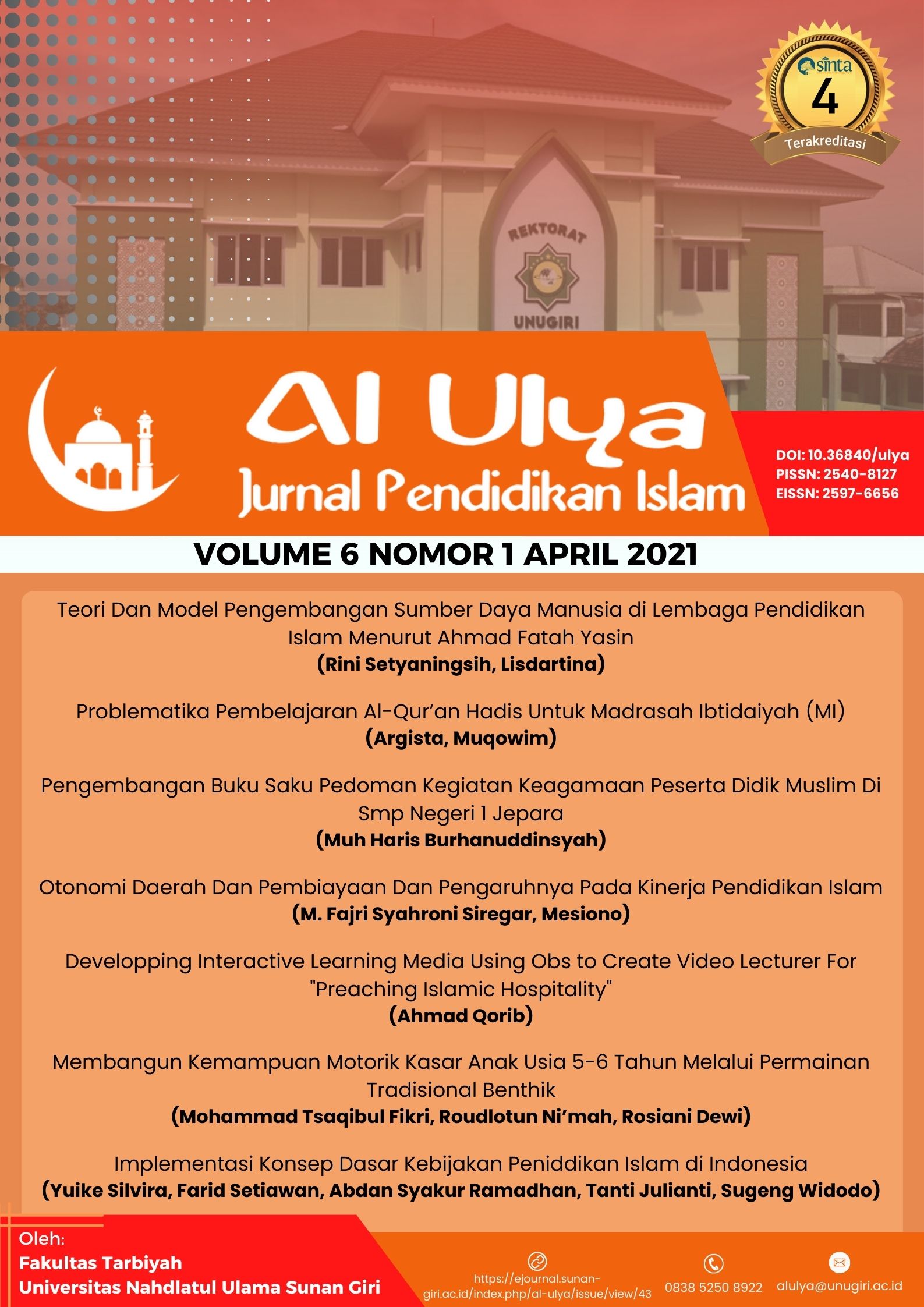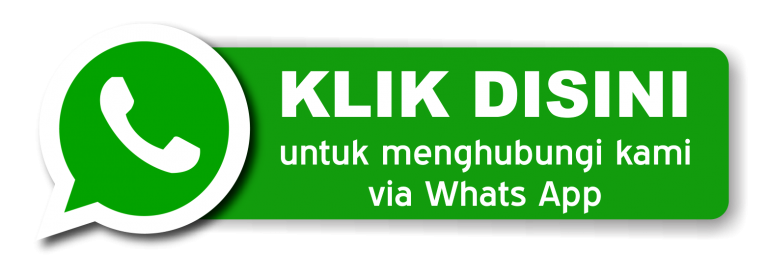DEVELOPPING INTERACTIVE LEARNING MEDIA USING OBS TO CREATE VIDEO LECTURER FOR "PREACHING ISLAMIC HOSPITALITY"
 pdf Download: 133
pdf Download: 133
DOI:
https://doi.org/10.36840/ulya.v6i1.438Keywords:
Learning media, video lecturer, OBSAbstract
Online learning faces a different set of obstacles than classroom-based learning. So that, it’s increases the using of video streaming and lecturer as media for teaching and learning activities. The use of this media in learning al Quran Hadith is intended to attract student's interest in designing blended learning model which combine both classroom-based learning and online learning systems. This media is important in considering that the materials of al Quran Hadith emphasizes more on memory. So that, playing videos repeatedly can help students to remember the materials. The type of this study is a research and development (R & D) which focuses on the developping interactive learning media using OBS studio application to create video lecturer on the material of “preaching Islamic hospitality. The model used in this study is the Borg and Gall's model which is simplified into eight steps, they are: 1). Preliminary research, 2). Planning, 3). Initial product development, 4). Initial product trial / limited trial, 5). Preliminary product enhancement, 6). Larger field trial, 7). Final product test. The products produced from this research are in the form of video lecturer that has been validated by some experts, they are: material experts, media experts and students’s responses as user. Based on the assessment and response, it was concluded that the interactive learning media using OBS studio application to create video lecturer was regarded feasible to be used and developed.
Downloads
References
B.R. Hergenhahn & Matthew H. Olson. Theories of Learning. 6th ed. Jakarta: Putra Grafika, 2017.
Bahasa, Tim Penyusun Kamus Pusat. Kamus Besar Bahasa Indonesia. Jakarta: Pusat Bahasa Depdiknas, 2008.
Batubara, Hamdan Husein, and Dessy Noor Ariani. “Pemanfaatan Video Sebagai Media Pembelajaran Matematika SD/MI.” Muallimuna : Jurnal Madrasah Ibtidaiyah 2, no. 1 (2016)
Batubara, Hamdan Husein, and Delila Sari Batubara. “Penggunaan Video Tutorial Untuk Mendukung Pembelajaran Daring Di Masa Pandemi Virus Corona.” Muallimuna : Jurnal Madrasah Ibtidaiyah 5, no. 2 (2020).
Chandra, Edy. “Youtube, Citra Media Informasi Interaktif Atau Media Penyampaian Aspirasi Pribadi.” Jurnal Muara Ilmu Sosial, Humaniora, dan Seni 1, no. 2 (2018).
Dwi, Marliat & Budiarto. Media Dan Metode Pembelajaran. Metode Pembelajaran. I. Vol. 03. Palembang: CV. Amanah, 2010.
Fatimatur Rusydiyah, Evi. Teknologi Pembelajaran (Implementasi Pembelajaran Era 4.0). I. Surabaya: UIN Sunan Ampel Press, 2019.
Hanisa, Resti Sekar. “Dampak Pembelajaran Daring Terhadap Perilaku-Perilaku Religius Di Tengah Situasi Social Distancing Akibat Pandemi Covid-19.” Al Ulya Jurnal Pendidikan Islam 5, no. 2 (2020).
Https://jagad.id/download/obs-studio/. “OBS Studio, Pengertian Kelebihan Dan Kekurangan,” 2020.
Ian Paul. “OBS Studio, The Most Powerful Screen Capture Tool,” 2021.
Iwantara, I. W., I W. Sadia, and I K. Suma. “Pengaruh Penggunaan Media Video Youtube Dalam Pemahaman Konsep Siswa.” E-Journal Program Pascasarjana Universitas Pendidikan Ganesha 4, no. 1 (2014).
Kaufmann, Daniel. “Using OBS to Create Video Lectures for Online Counseling Students.” Journal of Instructional Research 8, no. 2 (2019): 70–76.
Koshyk, Cyryl. Education in Pandemic Crisis Implementation via ICT Online Technologies. International Symposium on Computer Science, Computer Enginering and Educational Technology. Germany, 2020.
Marryono Jamun, Yohannes. “Dampak Teknologi Terhadap Pendidikan.” Widyatama 20, no. 10 (2018).
Mathews, James M. “Using a Studio-Based Pedagogy to Engage Students in the Design of Mobile-Based Media.” English Teaching 9, no. 1 (2010).
Mulyana, Aini. “Definiton, Purpose and Steps of Research and Development.” Https://Ainamulyana.Blogspot.Com/2016/08/Definition-Purpose-and-Steps-of.Html,. https://ainamulyana.blogspot.com/2016/08/definition-purpose-and-steps-of.html, 2016.
Munir. Multimedia Konsep & Aplikasi Dalam Pendidikan. Vol. 58, 2012.
Rosyidi, Abdul Wahab. “Media Pembelajaran Bahasa Arab.” Malang: UIN Malang Press, 2009.
Saprudin, Abdullah, and A Rasid Haerullah, Ade, Saraha. “EDUKASI - Jurnal Pendidikan.” Edukasi, Jurnal Pendidikan Islam 13, no. 2 (2015).
Sevima. “5 Kebijakan Pendidikan Masa Darurat Corona.” Sevima. Last modified 2020. https://sevima.com/5-kebijakan-pendidikan-masa-darurat-corona/.
Simo, Pep, Vicenc Fernandez, Ines Algaba, Nuria Salan, Mihaela Enache, Maria Albareda-Sambola, Edna R. Bravo, et al. “Video Stream and Teaching Channels: Quantitative Analysis of the Use of Low-Cost Educational Videos on the Web.” Procedia - Social and Behavioral Sciences 2, no. 2 (2010): 2937–2941. http://dx.doi.org/10.1016/j.sbspro.2010.03.444.
Sridevi, M., and Mayuri Kharde. “Video Summarization Using Highlight Detection and Pairwise Deep Ranking Model.” Procedia Computer Science 167, no. 2019 (2020): 1839–1848. https://doi.org/10.1016/j.procs.2020.03.203.
Sugiyono. “Metode Penelitian Kuantitatif, Kuantitatif, Dan R & D.” Bandung: Alfabeta, 2017.
Sukiman. Pengembangan Media Pembelajaran. Edited by M. Alaika Salmulloh. Pertama. Yogyakarta: Pedagogia, 2012.
Susilana, Rudi, and Cepi Riyana. Media Pembelajaran: Hakikat, Pengembangan, Pemanfaatan, Dan Penilaian. Kedua. Bandung: CV. Wacana Prima, 2008.
Tafonao, Talizaro. “Peranan Media Pembelajaran Dalam Meningkatkan Minat Belajar Mahasiswa.” Jurnal Komunikasi Pendidikan 2, no. 2 (2018): 103.
Taufiqurrochman. “Model Penelitian Pengembangan Borg and Gall (1983).” Taufiq.Net, 2020. https://www.taufiq.net/2019/09/model-penelitian-pengembangan-borg-and.html.
Ya’cub, Mihmidaty. “Media Pendidikan Perspektif Al Quran Hadits Dan Pengembangannya.” CENDEKIA : Jurnal Studi Keislaman 4, no. 2 (2018).
Zainuddin Tanjung. Media Pembelajaran. Buku Ajar, 2013.
Undang-Undang No. 20 Tahun 2003 Tentang SISDIKNAS, 2003.
Downloads
Published
Issue
Section
License
Copyright (c) 2021 Al Ulya : Jurnal Pendidikan Islam

This work is licensed under a Creative Commons Attribution-ShareAlike 4.0 International License.
 pdf Download: 133
pdf Download: 133












